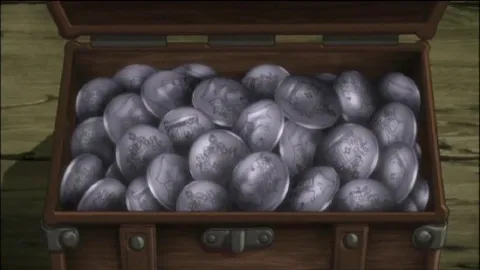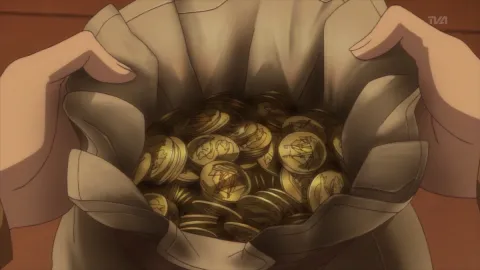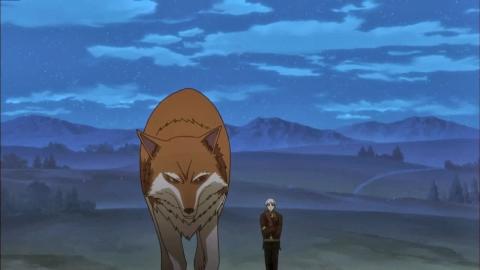An anime about the wolf-deity of the harvest in the form a beautiful young girl. This isn’t a theme you encounter a lot. The anime ‘Spice and Wolf’ (Ookami to Koushinryou) is not only fun but also educational. I was browsing to search for another anime to watch when I encountered this. I really got interested since I also like reading fantasy books. I expected something totally fictional, but it was a surprise to me that it was a mix of reality and fantasy.
Small summary

The anime is about Kraft Lawrence, a merchant who goes from town to town sell his goods. In the town of Pasloe, he finds a young girl in his cart. She introduces herself as the Holo, town’s wolf-God of harvest. Holo takes the form of a beautiful young girl with wolf ears and a tail. She wishes to go back to her hometown and so they set off together. They go from village to village making business deals. During their journey they experience all kinds of things and get to know each other better. They also discover more about her birthplace and the journey there is not easy.
My review
I personally think this is a very educational anime. You will not only learn about Holo, a god in the form of a wolf, but also about the currency and the way they traded stuff at that time. The anime is very nicely drawn and well put together. In addition to being an educational anime, it is also a romantic anime. In the beginning they are kind of hesitant, but you can see their feelings developing during the anime. The characters are well made, they are not boring, but they develop during the anime. It is cute to see how they are going from tolerating each other to liking each other. I also really like that this is a mix of fantasy and reality. I read a lot in my free time, and I prefer fantasy books or something not real. This way I can start imagining things and discover new worlds. Books with wolfs has always been one of my favorites so seeing a manga with a girl who is also a wolf-deity instantly peeked my interests.
Economy

Throughout the anime they make these business deals in the towns. With each deal, more explanation is given about the economy of that time and the currency system. Now we have the Euro, dollar, Yen and a few more. The currencies nowadays are fixed and won’t change. There used to be many more currencies, that would regularly change of value. You always had to exchange them for the correct currency to pay. This is also reflected in the anime. They have different coins: copper, silver, and gold coins. The values can constantly change because it is determined by the purity. The more silver is used to more the value rises. As they go from town to town, they regularly talk about all the different currencies and the fact that the value changes a lot. There is one particular scene where they were tricked by someone. He said that that if they invest a few silver coins that they would receive a lot of money since the value would rise. In the end it was a big lie. By making a deal with a big merchant group they could stop the lie and they received a part of the money that got returned. But during the anime they often did not travel with money but with goods. Why would they do this? Well, the reason is quite simple. It was safer this way since, there was less risk that things would be stolen. Rather than walking around with money they had these goods. In town they would trade their good for other goods. For example: they traded pepper for armor that they later could sell for something else. If they needed money, then they would trade it for money and when they would travel again, they bought goods that would sell well in the next town.

Another thing they talk about in this anime is business deals. In every town Kraft Lawrence makes a new business deal. Those deals come with risks, which you can also see in the anime. In the last town he tried to sell armor, there is one problem. The price for the armor dropped, because of this he owes some people a lot of money. He doesn’t have this money, so he makes another deal with the merchants. This goes on and on. Every deal is different and is a sort of game. You always try to get the best price, so you’re constantly playing a game with each other and testing each other’s limits. An example is when he tried to sell fur. He got a decent price, but Holo could make it even higher. Before they arrived by the buyer, she bought a lot of apples and ate them next to the furs. Because of this the fur smelled rather sweet, so she said they were even better quality. The buyer believed her and gave an even higher price but, in the end, it was just the apples who gave the sweet smell, so it was a trick. This shows that you must be smart and witty, which happen to be 2 characteristics of a wolf. I liked that it was also a bit of educational. You follow along while Holo also learns the way of trade.
Mythology of the wolf

Now economy and money aren’t the only thing they talk about during this anime. Holo is a wolf deity of harvest. Wolfs are one of my favorite animals. They are beautiful, smart, work together but they are also mysterious. This made me think about the mythology in Japan and if they would have their own myths about the wolf like we have ours. In Japanese the word for wolf is ookami, which also sounds like big god in Japanese. But they are not the same since they have different kanji. The Japanese character for wolf is a single kanji. The kanji has two parts, the left is translated as wild animal while the right part can be translated as good. So good animal. So, what about the myths? In Japan there is one specific group of people that have a lot of myths about the wolf, the Ainu. They are indigenous people who lived in the northern region, in particular Hokkaido. Hokkaido was also the place where a lot of wolves lived. There were namely two types of wolves in Japan, one of which was the Hokkaido wolf. No wonder they have a lot of myths. Some communities of the Ainu have a myth about the birth of the Ainu, the legend of the Horkew Kamuy. It is about the white wolf who mated with a goddess, their offspring are the ancestors of the Ainu. The Ainu lived with the wolves, there were even rumors about having raised wolf cubs with which they went hunting. But they aren’t the only one with myths about wolfs. Shinto is a religion in Japan, till this day you can still encounter the wolf in divine roles at their sanctuaries. The wolf is mostly seen as a divine messenger for the

deities who live in the mountains. Sometimes the wolf can also be a God. For example, Inari Okami or the kami of foxes. This is the God of fertility, agriculture, rice, … Another example is the Large-Mouthed Pure god who is in the form of a wolf, he is a protector deity. People used to co-exist with wolves, while the wolves never showed they did help with chasing away the animals that would ruin the fields. Therefore, the Large-Mouthed Pure God became the protector deity. The people would give him offering like deer in exchange for his protection. Wolves in Japanese mythology was often seen as the judges of humans, of character. This meant that only the good people would receive protection while the bad people would be punished. Those who fed the God would be seen as good people, since he is only a guardian when he is properly attended to and cared for. The mountains are often seen as dangerous, since they believed the wolf to be the protector of people, they associated the mountains with the wolf. There is even an escort wolf in the Japanese folklore, who would follow you while walking through a forest until you reached home. Because the wolf is seen as protector, there are also a lot of talismans and charms with images of wolves who are believed to protect. They used bits of wolf, such as teeth and hide, to make the charms strong. Even today they still worship the wolf in some places. An example is the Ooguchi magami matsuri. This is a wolf deity festival that takes place in January. They also made a game about the Ookami, where they combine the Japanese mythology and folklore to make this story about the Shinto sun goddess Amaterasu.
It’s not just an anime about a wolf deity but it’s also an educational anime. It talks about different topics while following the two characters. It’s interesting and funny but also exciting at moments. It’s definitely an anime that you can watch if you are interested in fantasy and wolfs. I could keep talking about this anime, but everything comes to an end.
Bibliography
“Currency | Spice & Wolf Wiki | Fandom.” n.d. Spice & Wolf Wiki. Accessed January 9, 2024. https://spiceandwolf.fandom.com/wiki/Currency.
Fukuyama, Jun, and Michael Tatum. n.d. “Spice and Wolf.” Wikipedia. Accessed January 9, 2024. https://en.wikipedia.org/wiki/Spice_and_Wolf.
“Hokkaido wolf.” n.d. Wikipedia. Accessed January 14, 2024. https://en.wikipedia.org/wiki/Hokkaido_wolf.
“Horkew Kamuy | The Cities Eternal.” 2016. The Cities Eternal. https://citieseternal.wordpress.com/tag/horkew-kamuy/.
“Inari Ōkami.” n.d. Wikipedia. Accessed January 31, 2024. https://en.wikipedia.org/wiki/Inari_%C5%8Ckami.
“Japanese wolf.” n.d. Wikipedia. Accessed January 9, 2024. https://en.wikipedia.org/wiki/Japanese_wolf.
Massey, Gerald. n.d. “Hokkaido Ainu legend of the Horkew Kamuy, the white wolf god.” japanese mythology & folklore. Accessed January 14, 2024. https://japanesemythology.wordpress.com/hokkaido-ainu-legend-of-the-horkew-kamuy-the-white-wolf-god/.
“Ōkami: Japanese Wolf Part 1 (Ep. 109).” 2022. Uncanny Japan. https://uncannyjapan.com/podcast/okami-japanese-wolf-part-1/.
“Reviews: Spice and Wolf.” n.d. IMDb. Accessed January 9, 2024. https://www.imdb.com/title/tt1158671/reviews.
Ueda, Masami, Hiroshi Yamaguchi, Akari Kaida, and Gerald de Jesus. n.d. “Ōkami.” Wikipedia. Accessed January 9, 2024. https://en.wikipedia.org/wiki/%C5%8Ckami.
“Wolf Gods: Japan & the Ainu: Wolf Mythologie and Wolf Gods, Mythologie japonais des loups, Creation Myths, Wolf Shrines in Japan, Mitsumine Jinja, Yamazumisama, Shirookami, white wolf, pure god, dieux-loups au Japon.” n.d. Ralph Häussler. Accessed January 31, 2024. https://ralphhaussler.weebly.com/wolf-mythologie-japan.html.
Reacties